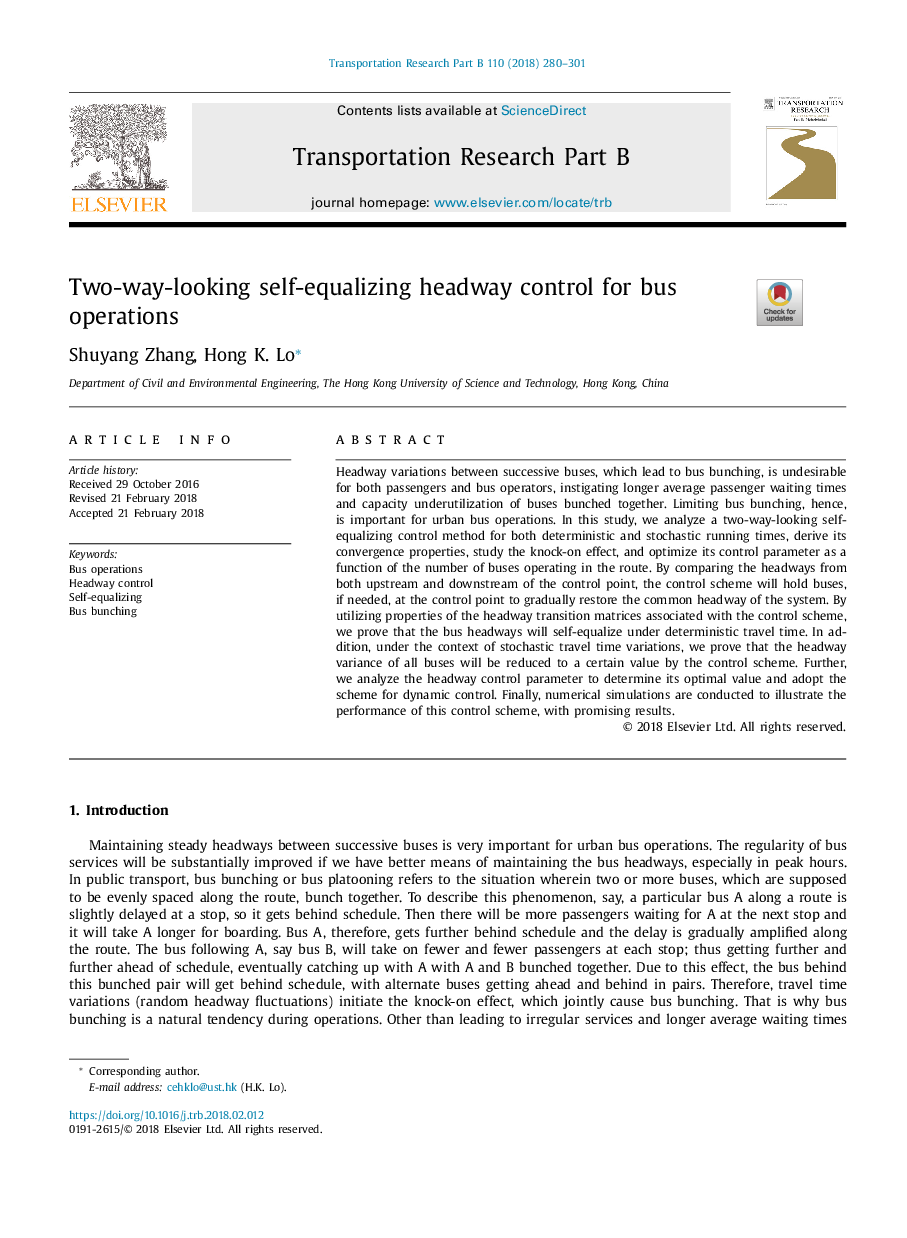| کد مقاله | کد نشریه | سال انتشار | مقاله انگلیسی | نسخه تمام متن |
|---|---|---|---|---|
| 7539133 | 1488936 | 2018 | 22 صفحه PDF | دانلود رایگان |
عنوان انگلیسی مقاله ISI
Two-way-looking self-equalizing headway control for bus operations
ترجمه فارسی عنوان
کنترل دو مسیری برای خودسانسنجی برای عملیات اتوبوس
دانلود مقاله + سفارش ترجمه
دانلود مقاله ISI انگلیسی
رایگان برای ایرانیان
کلمات کلیدی
عملیات اتوبوس، کنترل سربار، خودسنجی، دسته بندی اتوبوس،
ترجمه چکیده
تغییرات سرازیری بین اتوبوس های پی در پی که منجر به دسته بندی اتوبوس می شود، برای مسافران و اپراتورهای اتوبوس ناخوشایند است، باعث افزایش طول مدت انتظار مسافر طولانی و عدم استفاده از ظرفیت اتوبوس ها می شود. محدود کردن اتوبوس دسته بندی شده، از این رو برای عملیات اتوبوس های شهری مهم است. در این مطالعه، روش کنترل دو طرفه خودسانسنجی را برای هر دو زمان اجرا و زمانبندی تصادفی، خواص همگرائی خود را بررسی می کنیم، اثر ضربه را مطالعه می کنیم و پارامتر کنترل آن را به عنوان عملکرد تعداد اتوبوس ها بهینه می کنیم عامل در مسیر با مقایسه پیشروها از هر دو طرف بالادست و پایین دست از نقطه کنترل، طرح کنترل، در صورت لزوم، در نقطه کنترل، اتوبوس ها را نگه می دارد تا به تدریج راه های مشترک سیستم را بازیابی کند. با استفاده از خواص ماتریس های انتقال پیشرفت در ارتباط با طرح کنترل، ما ثابت می کنیم که پیشرفت های اتوبوس در زمان سفر قطعی خود برابر است. علاوه بر این، در شرایط تغییر زمان سفر اتفاقی، ما ثابت می کنیم که واریانس سرعتی تمام اتوبوس ها با طرح کنترل به مقدار معینی کاهش می یابد. علاوه بر این، پارامتر کنترل مسیر پیشرفت را برای تعیین ارزش مطلوب آن و طرح کنترل کنترل پویا مورد بررسی قرار می دهیم. در نهایت، شبیه سازی عددی برای نشان دادن عملکرد این طرح کنترل، با نتایج امیدوار کننده انجام می شود.
موضوعات مرتبط
علوم انسانی و اجتماعی
علوم تصمیم گیری
علوم مدیریت و مطالعات اجرایی
چکیده انگلیسی
Headway variations between successive buses, which lead to bus bunching, is undesirable for both passengers and bus operators, instigating longer average passenger waiting times and capacity underutilization of buses bunched together. Limiting bus bunching, hence, is important for urban bus operations. In this study, we analyze a two-way-looking self-equalizing control method for both deterministic and stochastic running times, derive its convergence properties, study the knock-on effect, and optimize its control parameter as a function of the number of buses operating in the route. By comparing the headways from both upstream and downstream of the control point, the control scheme will hold buses, if needed, at the control point to gradually restore the common headway of the system. By utilizing properties of the headway transition matrices associated with the control scheme, we prove that the bus headways will self-equalize under deterministic travel time. In addition, under the context of stochastic travel time variations, we prove that the headway variance of all buses will be reduced to a certain value by the control scheme. Further, we analyze the headway control parameter to determine its optimal value and adopt the scheme for dynamic control. Finally, numerical simulations are conducted to illustrate the performance of this control scheme, with promising results.
ناشر
Database: Elsevier - ScienceDirect (ساینس دایرکت)
Journal: Transportation Research Part B: Methodological - Volume 110, April 2018, Pages 280-301
Journal: Transportation Research Part B: Methodological - Volume 110, April 2018, Pages 280-301
نویسندگان
Shuyang Zhang, Hong K. Lo,
